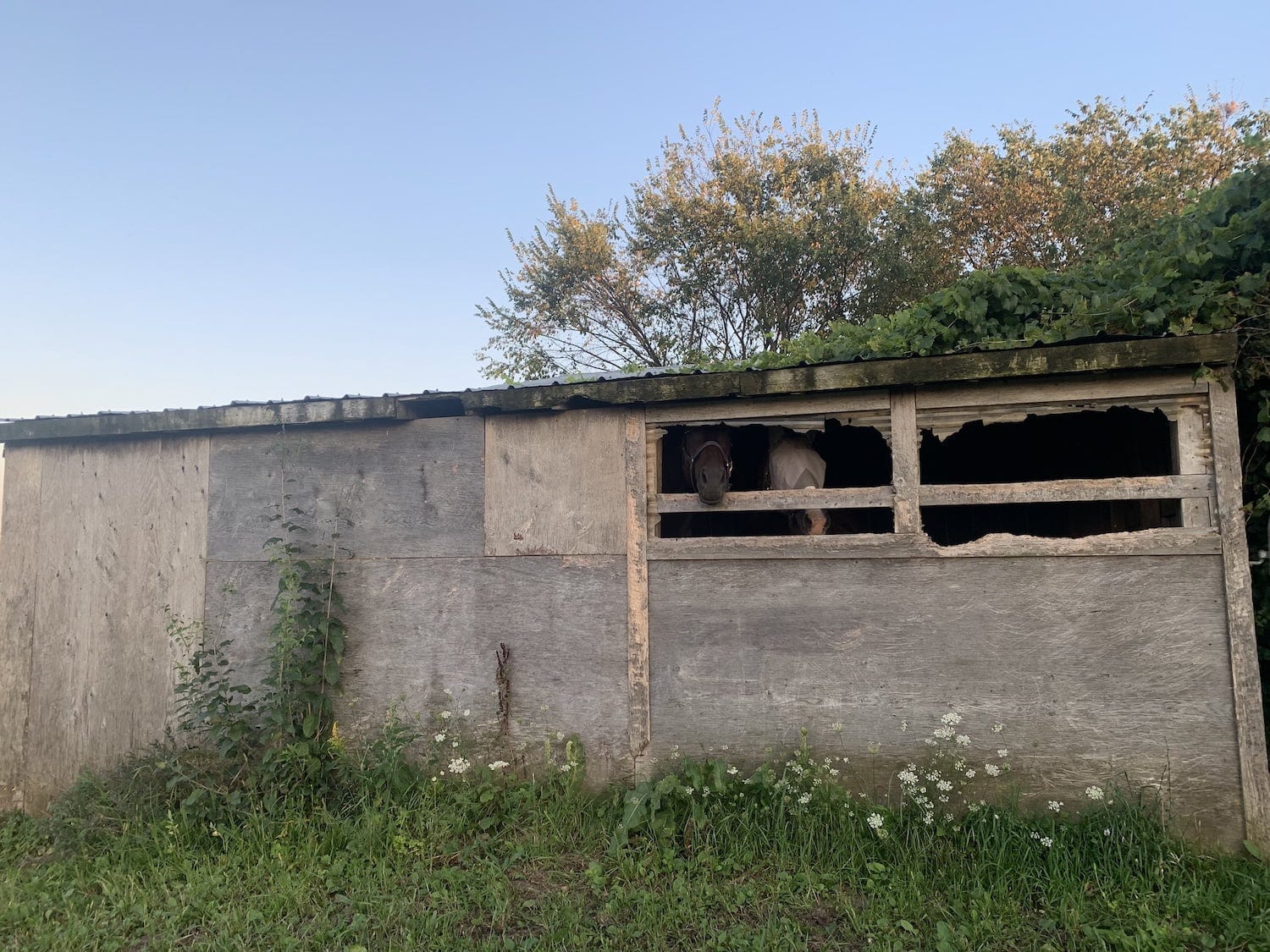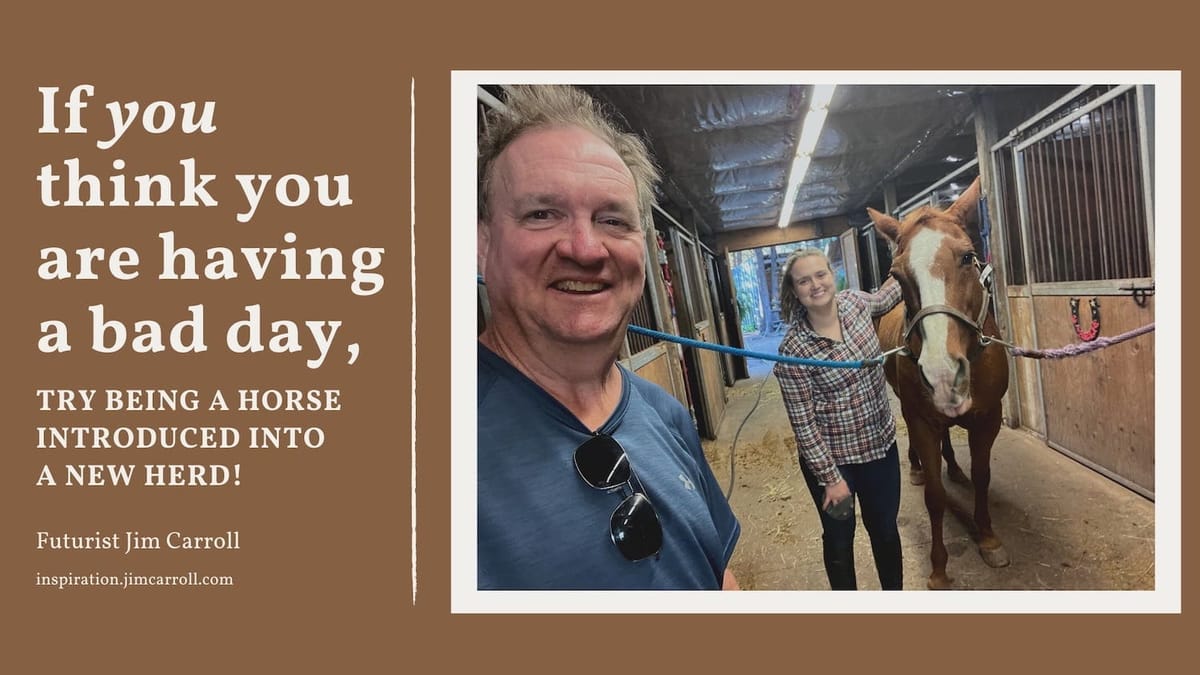Meet Dawn, and my daughter-in-law, Kim.
Dawn has been having a hard time, to say the least.
And I am pleased to know that things might finally be settling down.
The backstory? I spend a lot of my time on stage and in my leadership events speaking to the issues of change and change management. Talking about such things as how individuals should work harder to align themselves to a faster-moving future, adapt to rapidly changing circumstances, and be more accepting of the whirling world of change around them. Stuff like that.
As humans, we have it pretty easy when compared to what a horse has to go through.
Kim and my son Tom live relatively close to us in a small city outside Toronto, Canada. Guelph is known worldwide for its university agricultural program, among many other things. It's a small city with all the ambiance that comes with that - I can walk thirty seconds out my back door into a lush forest, and five minutes more and find myself in a field of corn or soybean. It's a wonderful place, and my wife and I discovered much joy when we moved here just over two years ago.
Tom and Kim moved here before us, and as part of that, found it necessary to move Dawn to a new barn. That worked out well for a time, but two weeks ago, Dawn had to be moved again due to some closures at the other place. Before the move, Kim and her father spoke of the complexities of what was involved. I didn't really hear much of what was said, but I assumed you stick the horse in a trailer, close the door, and move the darn thing. Case closed.
Boy, was I wrong!
Given what unfolded over the next little while, I ended up spending a lot of time learning about things I knew nothing about. Such as reading and learning about herd animal behavior, and how the process of introducing a new horse into a herd can be exceedingly difficult. How it can be excruciatingly difficult, and often needs to be managed with a series of incremental steps. How there can be some wild behavior and seemingly complex behavior along the way. Why? The bottom line, there is a definite hierarchy to the herd, and introducing a new animal into the mix can lead to some havoc.
There was a bit of havoc! At the old barn, Dawn was happily one of the dominant animals, a queen of her paddock. Her introduction into the new herd was less than smooth; there was a bit of bucking, some challenging behavior issues, and a few timeouts along the way. At one point, the dominant horse bit Dawn; at another point, a vet had to be called as there was real concern about her health. In perhaps the most poignant moment, the photo below was taken. Dawn had briefly formed a bond with another horse, but the two of them had retreated to the safety of a shed as the herd adaptation process continued to unfold in the erratic way that Mother Nature had dictated!

Apparently, all of this is quite common - anyone reading this who has owned a horse will be all-knowing about this. One particular online comment offered me comfort - since I oddly seemed to become emotionally wrapped up in the whole ordeal. This is from an article in Equus magazine, Introducing a New Horse to the Herd.
“Throughout the fray that usually arises when an unfamiliar horse arrives upon the scene, remember that the uproar is an innate aspect of equine nature. Horses have been fighting and surviving these introductory battles for at least 10,000 years, usually without benefit of safety precautions taken by concerned managers.
That awareness may be cold comfort as you watch the whirl of horses trying to sort out their new roles and relationships, but keep in mind that horses’ aggressive behavior is intended only to threaten, not to maim or kill. In a matter of hours or days the group will most likely have settled into a sedate routine once again with the outsider now an accepted member of a smooth-functioning social order.”
I am happy to report that things now seem to have calmed down somewhat; Dawn has spent the last couple of days grazing with the herd, enjoying the new paddock, and continuing to integrate herself into the new location. My daughter-in-law is now calmer too - I never understood how much emotional turmoil this could cause for the horse owner as well.
As for me?
I have learned far more about animal herd behavior than I thought I ever would! The things we don't know about in our lives and then discover become an overall part of our fascinating voyage of knowledge!
And through the process, I learned a little bit more about change management over and above what I preached about from the stage. Bringing a new horse into a herd is, perhaps, akin to introducing a teenager to a new high school. There is angst and anger, stress and worry, ousting and shunning. The same things that happen in high school - or a herd - can make their way into a workplace as we become adults. The established hierarchy is disrupted, roles are threatened, and dominance is challenged. Workplace change management upsets the existing herd, and much complexity - and havoc - ensues.
The things we don't know about any given issue could fill a book.(I also didn't know that a horse is given a show name when jumping, and when I first went to see Kim and Dawn in action, I could not understand why she was riding a horse called Rodeo Drive. That's her stage name!)
And learning them is often absolutely fascinating.
Here's to Dawn!
Futurist Jim Carroll rode a horse when he was 5 years old, at a birthday party. The horse walked straight into a pond, with Jim on its saddle. Traumatized, Jim has never ever been on a horse since.
Thank you for reading Jim Carroll's Daily Inspiration. This post is public so feel free to share it.

